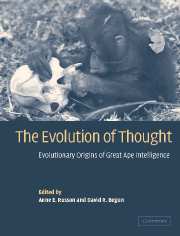Book contents
- Frontmatter
- Contents
- List of Contributors
- Preface
- 1 Evolutionary reconstructions of great ape intelligence
- 2 Enhanced cognitive capacity as a contingent fact of hominid phylogeny
- PART I COGNITION IN LIVING GREAT APES
- PART II MODERN GREAT APE ADAPTATION
- PART III FOSSIL GREAT APE ADAPTATIONS
- Part IV INTEGRATION
- 19 Evolutionary origins of great ape intelligence: an integrated view
- Author index
- Species index
- Subject index
19 - Evolutionary origins of great ape intelligence: an integrated view
Published online by Cambridge University Press: 20 August 2009
- Frontmatter
- Contents
- List of Contributors
- Preface
- 1 Evolutionary reconstructions of great ape intelligence
- 2 Enhanced cognitive capacity as a contingent fact of hominid phylogeny
- PART I COGNITION IN LIVING GREAT APES
- PART II MODERN GREAT APE ADAPTATION
- PART III FOSSIL GREAT APE ADAPTATIONS
- Part IV INTEGRATION
- 19 Evolutionary origins of great ape intelligence: an integrated view
- Author index
- Species index
- Subject index
Summary
Among the great apes that once ranged the forests of the Old World, only four species survive. Their evolutionary history reveals a huge range of morphological and behavioral diversity, all of which must be considered successful adaptations in their own time. Some of these attributes (large brains, sclerocarp and hard-object feeding, frugivory, folivory, gigantism, terrestriality, and suspensory positional behavior) survive in modern great apes. Our questions are: what combination of behaviors and attributes characterized the ancestor of living great apes? what was the significance of this suite of features for cognition? and how did it arise in evolution? To that end, we offer our model of a distinct great ape cognition along with its biological underpinnings and environmental challenges, then attempt to trace the evolutionary origins of this ensemble of features.
COGNITION
All living great apes express a distinctive grade of cognition intermediate between other nonhuman primates and humans. Their cognition normally reaches rudimentary symbolic levels, where symbolic means using internal signs like mental images to stand for referents or solving problems mentally. It supports rudimentary cognitive hierarchization or metarepresentation to levels of complexity in the range of human 2 to 3.5 year olds, but not beyond (in this volume, see Blake, Chapter 5, Byrne, Chapter 3, Parker, Chapter 4, Russon, Chapter 6, Yamakoshi, Chapter 9).
Great apes' high–level cognitive achievements are generalized in that they manifest system wide and relatively evenly across cognitive domains (Russon, Chapter 6, this volume).
- Type
- Chapter
- Information
- The Evolution of ThoughtEvolutionary Origins of Great Ape Intelligence, pp. 353 - 368Publisher: Cambridge University PressPrint publication year: 2004
- 16
- Cited by



